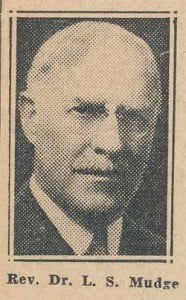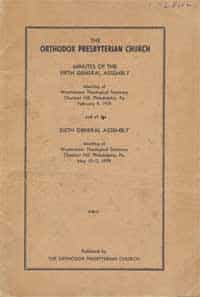You Can’t Say That!
Talk about Goliath against David. This was the case on this day April 28, 1937 when the Presbyterian Church in the United States of America went to court against the Presbyterian Church of America. They had been successful in winning the church properties of those ministers who had been suspended from their ranks. They had been successful in evicting them from the manse or parsonage. They had been successful in removing their life insurance policies. Now they wanted their name.
Their argument was simple. Plans had been under way for some time for a proposed union of the United Presbyterian Church of North America with the Presbyterian Church in the United States of America. And one of the names floated for that proposed union was the Presbyterian Church of America.
 The principal witness for the Presbyterian Church, U.S.A., was the denomination’s Stated Clerk, Lewis Seymour Mudge. Key to the whole case was the question of similarity of names as the sole basis for the suit against the Presbyterian Church of America. Attempts by the latter group to show the doctrinal reasons for the new church were then met with objection after objection by the attorney for the Presbyterian Church, U.S.A.
The principal witness for the Presbyterian Church, U.S.A., was the denomination’s Stated Clerk, Lewis Seymour Mudge. Key to the whole case was the question of similarity of names as the sole basis for the suit against the Presbyterian Church of America. Attempts by the latter group to show the doctrinal reasons for the new church were then met with objection after objection by the attorney for the Presbyterian Church, U.S.A.
Witnesses for the P.C. of A. were a “who’s who” of its early leaders. Ministers Paul Woolley, Edwin Rian, and Charles Woodbridge all testified on April 28 and April 29. Professor John Murray tried to bear witness about the doctrinal differences between the two denominations, but was hindered by objections to his presence on the stand. He left, without testifying.
It took several months before the decision was handed down. But as the historical devotional for February 9, 1939 showed, the decision was made against the Presbyterian Church of America. Moderator R.B. Kuiper called for an earlier than usual General Assembly in that month of February, 1939, and the new name of the Orthodox Presbyterian Church was chosen by the church.
When the union between the Presbyterian Church of the United States of America and the United Presbyterian Church of North America took place in 1958, their new name was the United Presbyterian Church in the United States of America (UPCUSA). In God’s providence, this gave the opportunity for the southern Presbyterians who left the Presbyterian Church in the United States in 1973 to choose the name, The Presbyterian Church in America, as their new name during their second General Assembly.

 Presbyterian Guardian managing editor Thomas R. Birch remarked at the close of his report in the May 29th, 1937 issue, “And once more . . . Gideon’s band of true Christians, the Presbyterian Church of America, has publicly taken its unflinching stand on the side of historic Presbyterianism and the principles of religious liberty for which the fathers fought and died.” His entire article concerning the injunction can be read online in the May 29, 1937 issue of the Presbyterian Guardian. Yet through further legal appeal, it was not until March 15, 1939 that the denomination officially changed its name to The Orthodox Presbyterian Church. Mr. Birch wrote again at that time regarding the name change, “What’s In A Name?”, on page 47 of the March 1939 issue of The Presbyterian Guardian.
Presbyterian Guardian managing editor Thomas R. Birch remarked at the close of his report in the May 29th, 1937 issue, “And once more . . . Gideon’s band of true Christians, the Presbyterian Church of America, has publicly taken its unflinching stand on the side of historic Presbyterianism and the principles of religious liberty for which the fathers fought and died.” His entire article concerning the injunction can be read online in the May 29, 1937 issue of the Presbyterian Guardian. Yet through further legal appeal, it was not until March 15, 1939 that the denomination officially changed its name to The Orthodox Presbyterian Church. Mr. Birch wrote again at that time regarding the name change, “What’s In A Name?”, on page 47 of the March 1939 issue of The Presbyterian Guardian.
Words to Live By: Jesus promised His followers that they would be brought up before the courts for the sake of their profession as Christianity. This was one such example, and it will not be the last time in the history of the Christian church. Yet God’s Word is sure. Remain steadfast to the faith, and God’s reward will be ultimately yours in Christ.
And to Explain:
Lest you be confused, the original name of what is now The Orthodox Presbyterian Church, was the Presbyterian Church of America. They legally had that name from their founding in 1936 until the decision was made that they simply did not have the funds to fight the PCUSA legal challenge, and so gave up the court battle and changed their name in 1939.
Fast forward to 1973, and a new denomination began, gathering some 40,000 members out from the old Southern Presbyterian Church. This new group initially called themselves the National Presbyterian Church, but because of a discovered conflict, chose to change its name a year later. It was their own choice; no legal challenge was involved. And the name selected in 1974 was the Presbyterian Church in America. Why was there no legal challenge about the PCinA name, you ask? Because the mainline denomination was, by way of a merger, operating as the United Presbyterian Church in the U.S.A. from 1958-1983, and the PCinA name was not in view as something they might employ.
So to review, PCofA, 1936-1939, which then becomes the OPC, 1939-ongoing; and NPC, 1973-74, which then becomes the PCinA, 1974-ongoing.

Thank you for your additional explanation. Yes, it does get somewhat confusing.
God bless,
Craig